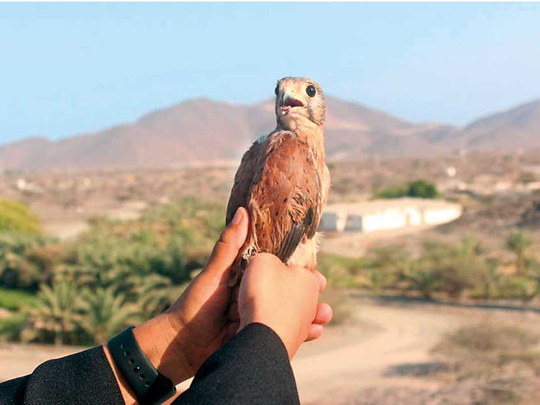
Sharjah: An injured bird of prey from the falcon family, was given a new lease of life and was helped to fly again over the Kalba mountains, thanks to the efforts of the Environment and Protected Areas Authority (EPPA) in Sharjah.
The authority’s Eastern Region Branch was able to provide various treatments to the injured bird, a common kestrel, EPAA said in a press release.
Hana Saif Al Suwaidi, chairperson of the EPAA underlined the importance of protecting endangered birds and animals to maintain the biodiversity and natural life in line with the vision of His Highness Dr Shaikh Sultan bin Mohammad Al Qasimi, Member of the Supreme Council and Ruler of Sharjah, and the keenness of the emirate of Sharjah to provide proper conditions to breed various kinds of species which reflects the richness of the environment and the nature of the UAE.
Awatif Al Naqbi, EPAA Eastern Region branch manager, said that the injured bird was found in a residential area in Kalba City.
“It was in an extremely poor condition, unable to fly or move at all." Al Naqbi said the EPAA specialised team took the bird to veterinary physicians to provide the required treatment.
Al Naqbi said after treatment, the bird was sent to the Bird of Prey Centre for full recovery and it was released to fly again over the Kalba mountains,” she said.
Al Naqbi noted that common kestrel is usually found in rocky or stone mountains. “It is a partial migrant bird in multiple numbers, visiting the UAE in winter, with a bunch of them breeding here. Breeding pairs of common kestrels are found in mountains, some rocky islands, and, very rarely, on buildings. These birds can be found in multiple environments extending from mountains to desert, agricultural fields, parks, gardens and cities.”
This kind of falcon is very widespread in Europe, Asia and Africa. The northern species of common kestrel are migrant birds that spend winter in areas extending from the Arabian Peninsula to Southeast Asia. Adult common kestrel males can be distinguished from other kestrels by their reddish upper parts, absence of the broad grey-blue line, pale heads and a large number of black spots on the upper parts of the feathers. Female kestrels are almost identical.
In short-term vision, the black, or sometimes ivory white, claws of female kestrels can be seen. Kestrels do not exist in flocks, rather either alone or in breeding pairs.












